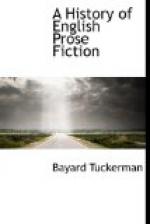[Footnote 210: Other American writers of fiction:—R.B. Kimball, Herman Melville, Dr. R. Bird, John Neal, H.W. Longfellow, Washington Allston, Maria S. Cummins, W.G. Simms, Theodore Winthrop, Mary J. Holmes, Mrs. Terhune, Augusta Evans Wilson, Catherine Sedgwick Valerio.]
VII.
The historical novel is obviously a subdivision of the novel of life and manners. But, dealing as it does with remote ages, with forgotten opinions and long-disused customs, it has to reconstruct where the novel of contemporary life has only to illustrate. Strict historical accuracy can hardly be expected in fiction concerned with the past. The details of life, always difficult to seize, are almost beyond the reach of the novelist who deals with a subject with which he has had no personal experience. A certain amount of accuracy concerning dress, customs, peculiarities of opinion and language are necessary to give to a historical novel the effect of verisimilitude. But what is chiefly requisite in such a work is that the general spirit of the period treated should be successfully caught; that the reader should find himself occupied with a train of associations and sympathies which insensibly withdraws his thoughts from their ordinary channels, and occupies them with the beliefs, opinions, and aspirations of a totally different state of society.
Such is the special merit of Scott’s historical novels. Many inaccuracies of fact might be pointed out in them. His study of the character of James I, in “The Fortunes of Nigel,” is in several respects entirely mistaken. His description of a euphuist in “The Monastery” bears no resemblance whatever to the followers of John Lyly. In “The Talisman” and in “Ivanhoe,” of which the scenes are laid in the time of Richard Coeur de Lion, the reader recognises little realism of language. But as Scott’s historical novels deal with periods extending from that of the crusades down to the Pretender’s attempt in 1745, an intimate knowledge of the innumerable social changes and peculiarities is not to be expected.
It is, indeed, to be doubted that a novelist can so reproduce a distant epoch as to satisfy the ideas of careful historical students. He can, however, make familiar to his readers the general spirit of a time. And, in this, Scott was eminently successful. “Kenilworth” gives a vivid picture of the gay picturesqueness of Elizabeth’s age. “Woodstock” contains a fine contrast between the Cavalier and the Puritan character. “Quentin Durward” affords a lasting impression of the times of Louis XI and Charles the Bold. Scott’s strong national feeling and his intense sympathy with the traditions of his native land naturally gave to his Scotch fictions a particular historical value. “The Legend of Montrose,” describing the civil war in the sixteenth century; “Old Mortality,” dealing with the rebellion of the Covenanters; and “Waverley,” occupied with the Pretender’s




